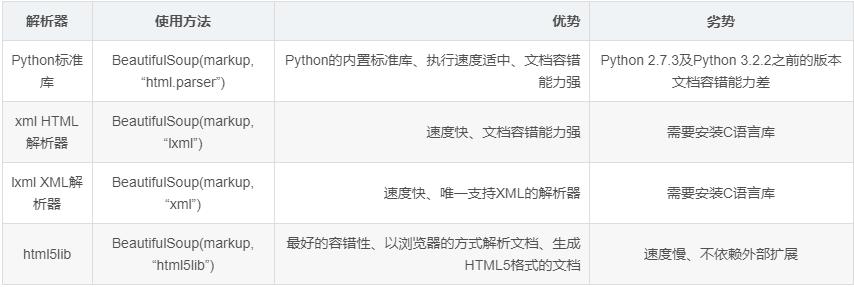Beautiful Soup就是Python的一个HTML或XML的解析库,可以用它来方便地从网页中提取数据。它有如下三个特点:
- Beautiful Soup提供一些简单的、Python式的函数来处理导航、搜索、修改分析树等功能。它是一个工具箱,通过解析文档为用户提供需要抓取的数据,因为简单,所以不需要多少代码就可以写出一个完整的应用程序。
- Beautiful Soup自动将输入文档转换为Unicode编码,输出文档转换为UTF-8编码。你不需要考虑编码方式,除非文档没有指定一个编码方式,这时你仅仅需要说明一下原始编码方式就可以了。
- Beautiful Soup已成为和lxml、html6lib一样出色的Python解释器,为用户灵活地提供不同的解析策略或强劲的速度。
首先,我们要安装它:pip install bs4,然后安装 pip install beautifulsoup4.
Beautiful Soup支持的解析器

下面我们以lxml解析器为例:
from bs4 import BeautifulSoup
soup = BeautifulSoup('Hello
', 'lxml')
print(soup.p.string)
结果:
Hello
beautiful soup美化的效果实例:
html = """ <html><head><title>The Dormouse's story</title></head> <body> <p class="title" name="dromouse"><b>The Dormouse's story</b></p> <p class="story">Once upon a time there were three little sisters; and their names were <a href="http://example.com/elsie" rel="external nofollow" rel="external nofollow" rel="external nofollow" class="sister" id="link1"><!-- Elsie --></a>, <a href="http://example.com/lacie" rel="external nofollow" rel="external nofollow" rel="external nofollow" class="sister" id="link2">Lacie</a> and <a href="http://example.com/tillie" rel="external nofollow" rel="external nofollow" rel="external nofollow" class="sister" id="link3">Tillie</a>; and they lived at the bottom of a well.</p> <p class="story">...</p> """ from bs4 import BeautifulSoup soup = BeautifulSoup(html, 'lxml')#调用prettify()方法。这个方法可以把要解析的字符串以标准的缩进格式输出 print(soup.prettify()) print(soup.title.string)结果:
<html> <head> <title> The Dormouse's story </title> </head> <body> <p class="title" name="dromouse"> <b> The Dormouse's story </b> </p> <p class="story"> Once upon a time there were three little sisters; and their names were <a class="sister" href="http://example.com/elsie" rel="external nofollow" rel="external nofollow" rel="external nofollow" id="link1"> <!-- Elsie --> </a> , <a class="sister" href="http://example.com/lacie" rel="external nofollow" rel="external nofollow" rel="external nofollow" id="link2"> Lacie </a> and <a class="sister" href="http://example.com/tillie" rel="external nofollow" rel="external nofollow" rel="external nofollow" id="link3"> Tillie </a> ; and they lived at the bottom of a well. </p> <p class="story"> ... </p> </body> </html> The Dormouse's story下面举例说明选择元素、属性、名称的方法
html = """ <html><head><title>The Dormouse's story</title></head> <body> <p class="title" name="dromouse"><b>The Dormouse's story</b></p> <p class="story">Once upon a time there were three little sisters; and their names were <a href="http://example.com/elsie" rel="external nofollow" rel="external nofollow" rel="external nofollow" class="sister" id="link1"><!-- Elsie --></a>, <a href="http://example.com/lacie" rel="external nofollow" rel="external nofollow" rel="external nofollow" class="sister" id="link2">Lacie</a> and <a href="http://example.com/tillie" rel="external nofollow" rel="external nofollow" rel="external nofollow" class="sister" id="link3">Tillie</a>; and they lived at the bottom of a well.</p> <p class="story">...</p> """ from bs4 import BeautifulSoup soup = BeautifulSoup(html, 'lxml') print('输出结果为title节点加里面的文字内容:\n',soup.title) print('输出它的类型:\n',type(soup.title)) print('输出节点的文本内容:\n',soup.title.string) print('结果是节点加其内部的所有内容:\n',soup.head) print('结果是第一个p节点的内容:\n',soup.p) print('利用name属性获取节点的名称:\n',soup.title.name) #这里需要注意的是,有的返回结果是字符串,有的返回结果是字符串组成的列表。 # 比如,name属性的值是唯一的,返回的结果就是单个字符串。 # 而对于class,一个节点元素可能有多个class,所以返回的是列表。 print('每个节点可能有多个属性,比如id和class等:\n',soup.p.attrs) print('选择这个节点元素后,可以调用attrs获取所有属性:\n',soup.p.attrs['name']) print('获取p标签的name属性值:\n',soup.p['name']) print('获取p标签的class属性值:\n',soup.p['class']) print('获取第一个p节点的文本:\n',soup.p.string)结果:
输出结果为title节点加里面的文字内容: <title>The Dormouse's story</title> 输出它的类型: <class 'bs4.element.Tag'> 输出节点的文本内容: The Dormouse's story 结果是节点加其内部的所有内容: <head><title>The Dormouse's story</title></head> 结果是第一个p节点的内容: <p class="title" name="dromouse"><b>The Dormouse's story</b></p> 利用name属性获取节点的名称: title 每个节点可能有多个属性,比如id和class等: {'class': ['title'], 'name': 'dromouse'} 选择这个节点元素后,可以调用attrs获取所有属性: dromouse 获取p标签的name属性值: dromouse 获取p标签的class属性值: ['title'] 获取第一个p节点的文本: The Dormouse's story在上面的例子中,我们知道每一个返回结果都是bs4.element.Tag类型,它同样可以继续调用节点进行下一步的选择。
html = """ <html><head><title>The Dormouse's story</title></head> <body> """ from bs4 import BeautifulSoup soup = BeautifulSoup(html, 'lxml') print('获取了head节点元素,继续调用head来选取其内部的head节点元素:\n',soup.head.title) print('继续调用输出类型:\n',type(soup.head.title)) print('继续调用输出内容:\n',soup.head.title.string)结果:
获取了head节点元素,继续调用head来选取其内部的head节点元素: <title>The Dormouse's story</title> 继续调用输出类型: <class 'bs4.element.Tag'> 继续调用输出内容: The Dormouse's story(1)find_all()
find_all,顾名思义,就是查询所有符合条件的元素。给它传入一些属性或文本,就可以得到符合条件的元素,它的功能十分强大。
find_all(name , attrs , recursive , text , **kwargs)
他的用法:
html=''' <div class="panel"> <div class="panel-heading"> <h4>Hello</h4> </div> <div class="panel-body"> <ul class="list" id="list-1"> <li class="element">Foo</li> <li class="element">Bar</li> <li class="element">Jay</li> </ul> <ul class="list list-small" id="list-2"> <li class="element">Foo</li> <li class="element">Bar</li> </ul> </div> </div> ''' from bs4 import BeautifulSoup soup = BeautifulSoup(html, 'lxml') print('查询所有ul节点,返回结果是列表类型,长度为2:\n',soup.find_all(name='ul')) print('每个元素依然都是bs4.element.Tag类型:\n',type(soup.find_all(name='ul')[0])) #将以上步骤换一种方式,遍历出来 for ul in soup.find_all(name='ul'): print('输出每个u1:',ul.find_all(name='li')) #遍历两层 for ul in soup.find_all(name='ul'): print('输出每个u1:',ul.find_all(name='li')) for li in ul.find_all(name='li'): print('输出每个元素:',li.string)结果:
查询所有ul节点,返回结果是列表类型,长度为2: [<ul class="list" id="list-1"> <li class="element">Foo</li> <li class="element">Bar</li> <li class="element">Jay</li> </ul>, <ul class="list list-small" id="list-2"> <li class="element">Foo</li> <li class="element">Bar</li> </ul>] 每个元素依然都是bs4.element.Tag类型: <class 'bs4.element.Tag'> 输出每个u1: [<li class="element">Foo</li>, <li class="element">Bar</li>, <li class="element">Jay</li>] 输出每个u1: [<li class="element">Foo</li>, <li class="element">Bar</li>] 输出每个u1: [<li class="element">Foo</li>, <li class="element">Bar</li>, <li class="element">Jay</li>] 输出每个元素: Foo 输出每个元素: Bar 输出每个元素: Jay 输出每个u1: [<li class="element">Foo</li>, <li class="element">Bar</li>] 输出每个元素: Foo 输出每个元素: Bar以上就是本文的全部内容,希望对大家的学习有所帮助,也希望大家多多支持python博客。
- Beautiful Soup提供一些简单的、Python式的函数来处理导航、搜索、修改分析树等功能。它是一个工具箱,通过解析文档为用户提供需要抓取的数据,因为简单,所以不需要多少代码就可以写出一个完整的应用程序。
- << 上一篇 下一篇 >>
面向新手解析python Beautiful Soup基本用法
看: 1677次 时间:2020-08-29 分类 : python教程
- 相关文章
- 2021-12-20Python 实现图片色彩转换案例
- 2021-12-20python初学定义函数
- 2021-12-20图文详解Python如何导入自己编写的py文件
- 2021-12-20python二分法查找实例代码
- 2021-12-20Pyinstaller打包工具的使用以及避坑
- 2021-12-20Facebook开源一站式服务python时序利器Kats详解
- 2021-12-20pyCaret效率倍增开源低代码的python机器学习工具
- 2021-12-20python机器学习使数据更鲜活的可视化工具Pandas_Alive
- 2021-12-20python读写文件with open的介绍
- 2021-12-20Python生成任意波形并存为txt的实现
-
搜索
-
-
推荐资源
-
Powered By python教程网 鲁ICP备18013710号
python博客 - 小白学python最友好的网站!